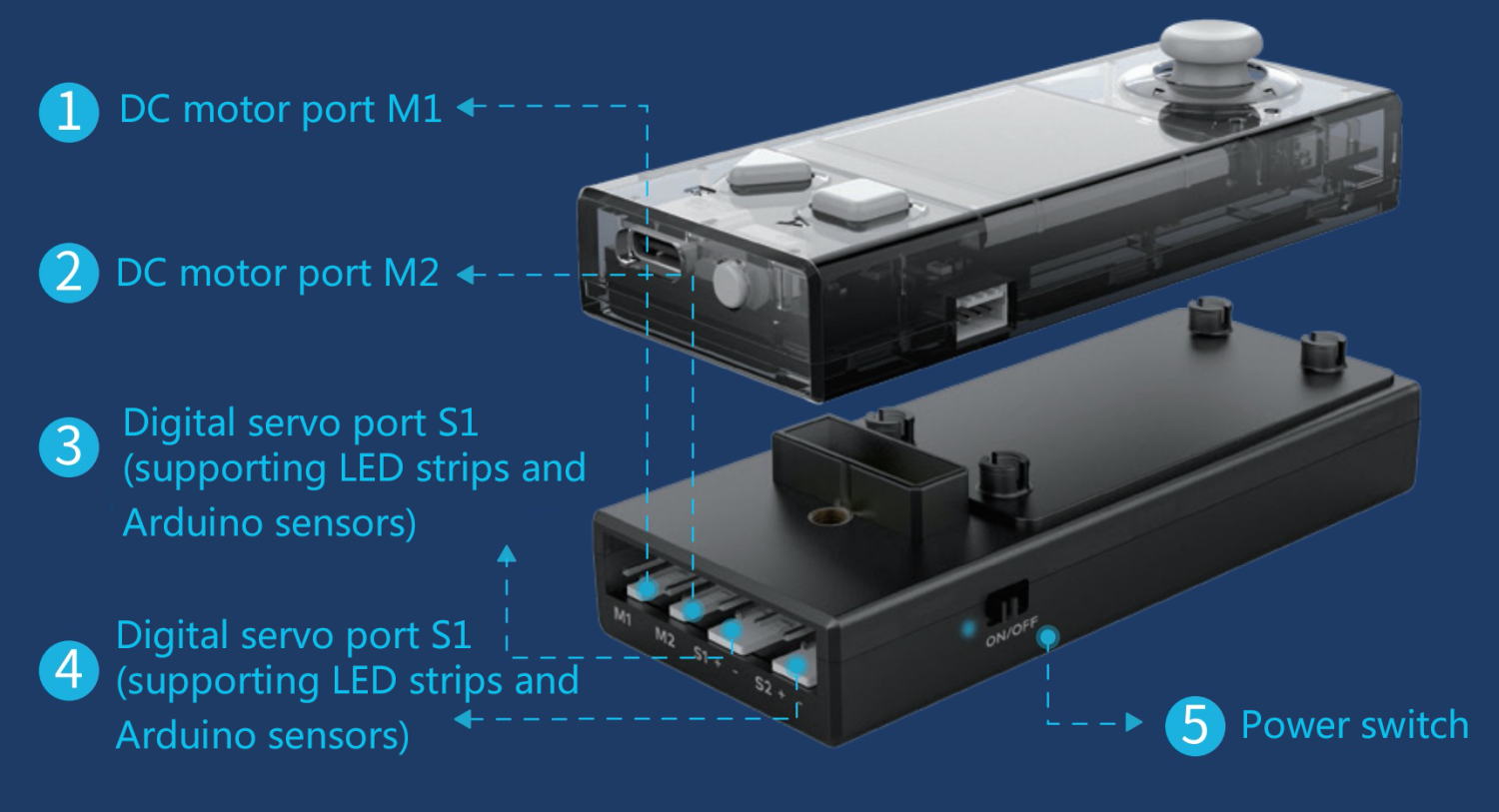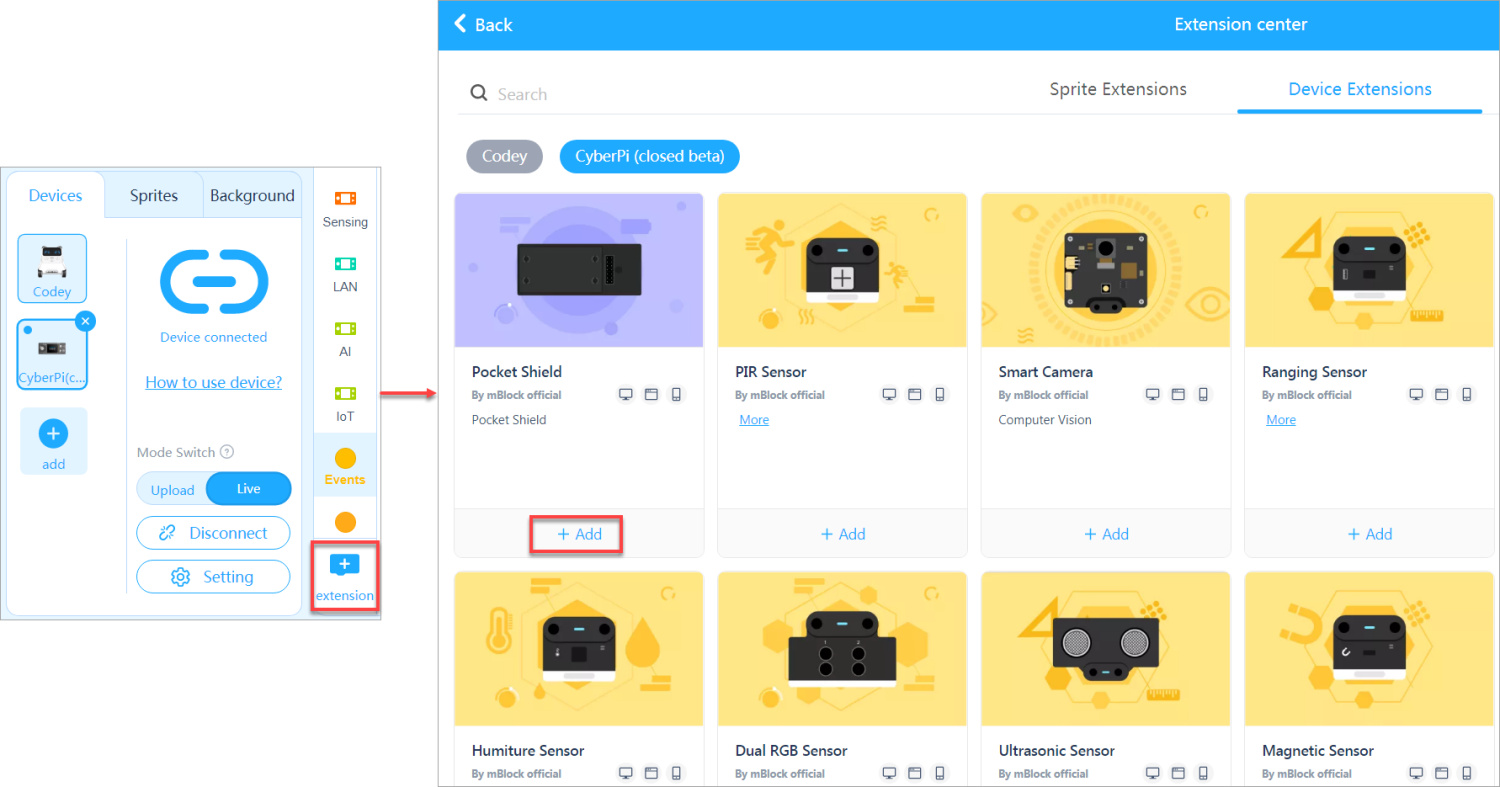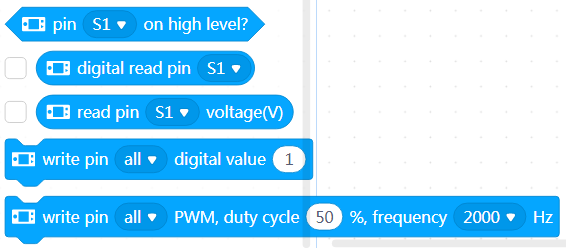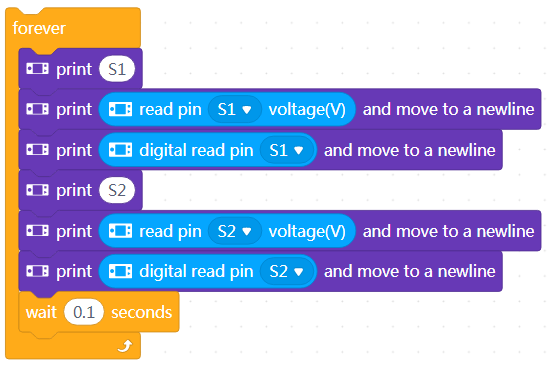How Can We Help?
Pocket Shield Operation Guide
Pocket Shield Operation Guide
 |
English |
| 日本語 |
1. Know about Pocket Shield
Pocket Shield provides the following functions for CyberPi:
- Supplying power
- Extending functions
1.1 Supplying power
Pocket Shield is equipped with a rechargeable 800 mAh Li-ion battery that can be charged while supplying power for CyberPi. In general, Pocket Shield can supply power for CyberPi for more than four hours after being fully charged. The duration, however, depends on the load of the battery.
1.2 Extending functions
Pocket Shield provides two types of ports, namely 2-pin and 3-pin ports, which are designed with an anti-plug mechanism and the pin spacing of 2.54 mm. The 2-pin ports can be used to connect motors and the 3-pin ones can be used to connect servos or LEDs strips.
In addition, you can connect third-party sensors to Pocket Shield through DuPont wires.

Supported motors
Pocket Shield drives DC motors, water pumps, and fans at a higher voltage (5V) to provide better operation performance, including the torque and rotational speed. This may, however, cause Pocket Shield to fail to drive motors that work well with the earlier products we have developed.
The earlier products we have developed, such as mBot, drive motors at the voltage of 3.7V. The start current of a motor becomes higher when it is driven at a higher voltage, and therefore the start current of such motors may exceed the current limit designed for the protection of the driving chip of Pocket Shield.
To ensure compatibility, refer to the motor driving specifications of Pocket Shield when purchasing motors for it or purchase the motor pack we are going to launch for Pocket Shield.
| Pin spacing | 2.54 mm |
| Output voltage | 5 V |
| Operating current | < 1.2 A |
| Max. transient current | 2.4–4.8 A |
Supported servos
Servos developed by Makeblock are recommended.
Pocket Shield is compatible with third-party servos, but slight angle deviations may occur due to the component protocols.

| Pin spacing | 2.54 mm |
| Operating voltage | 5 V |
| Operating current | < 1.6 A |
Supported LED strips
The digital servo ports can also be used to connect LED strips.
LED strips developed by Makeblock are recommended.
Pocket Shield is compatible with third-party LED strips, but control exceptions may occur due to the definition differences of high and low levels in the component protocols.

Supported third-party sensors
The output voltage of Pocket Shield is 5 V. It is well compatible with Arduino digital and analog sensors and output modules. The operating voltage of micro:bit sensors is 3.3 V, and therefore Pocket Shield may not work well with them.
 (DF sensor used)
(DF sensor used)
2. Add the Pocket Shield extension
Click + extension and then click + Add in the extension center to add the Pocket Shield extension.

The following blocks are provided in the Pocket Shield extension, indicating the functions that have been developed.

Among them, the following ones are developed for third-party sensors.

3. Python APIs
For information about the APIs for Pocket Shield, see “APIs for Pocket Shield” in the Python API Documentation for CyberPi.
4. Online help
After-sales services and technical support
If you encounter any product quality problems or find any parts missing or damaged when you open the package, or if you need any technical support, contact us for after-sales services through:
support@makeblock.com
(Service hours: 9:00–12:00 & 14:00–18:30 from Monday to Friday)
Feedback and suggestions
Should you have any feedback or suggestions on CyberPi, contact our R&D team through:
cyber.list@makeblock.com
5. FAQs
How long does it take to fully charge Pocket Shield?
Within two hours. It can be charged faster when powered off.
Can I use CyberPi and Pocket Shield to participate in the Arduino competition?
Working with Pocket Shield, CyberPi supports Arduino modules and parts, but it is a new-generation open-source device designed based on China-made chips instead of Arduino hardware.
CyberPi is designed with high compatibility and can communicate with Arduino main control boards through serial ports or Bluetooth. Therefore, you can use CyberPi as an input or output part for Arduino main control boards to implement powerful and abundant AI and IoT functions in your Arduino projects.
What if the voltage of pins can’t be properly obtained?
This is caused by the errors that occur during the switching of pin modes. A new firmware version will be released in August to solve this problem. At present, you can refer to the following program to switch the pins to the correct states to ensure proper voltage output.

How to update the firmware?
- Connect Pocket Shield to CyberPi through the CyberPi port.
- Use a Type-C USB cable to connect CyberPi to your PC, and turn on Pocket Shield.

- Open the mBlock 5 PC client or webpage, connect CyberPi to mBlock 5, and set the programming mode to Live.
If mBlock 5 prompts you to update the firmware, as shown in the following figure, you need to update the firmware of CyberPi or Pocket Shield.
Click Update. mBlock 5 updates CyberPi or Pocket Shield to the latest firmware version.

6. More information
Python API Documentation for CyberPi
mBlock-Python Editor Online Help
